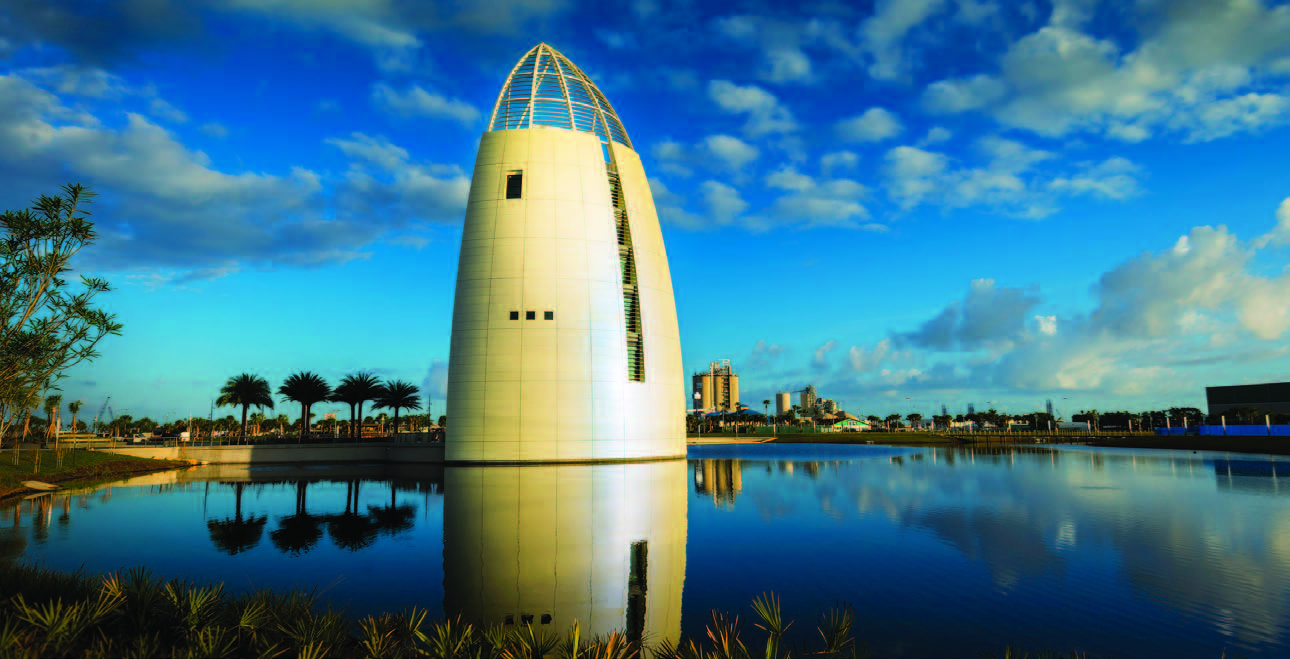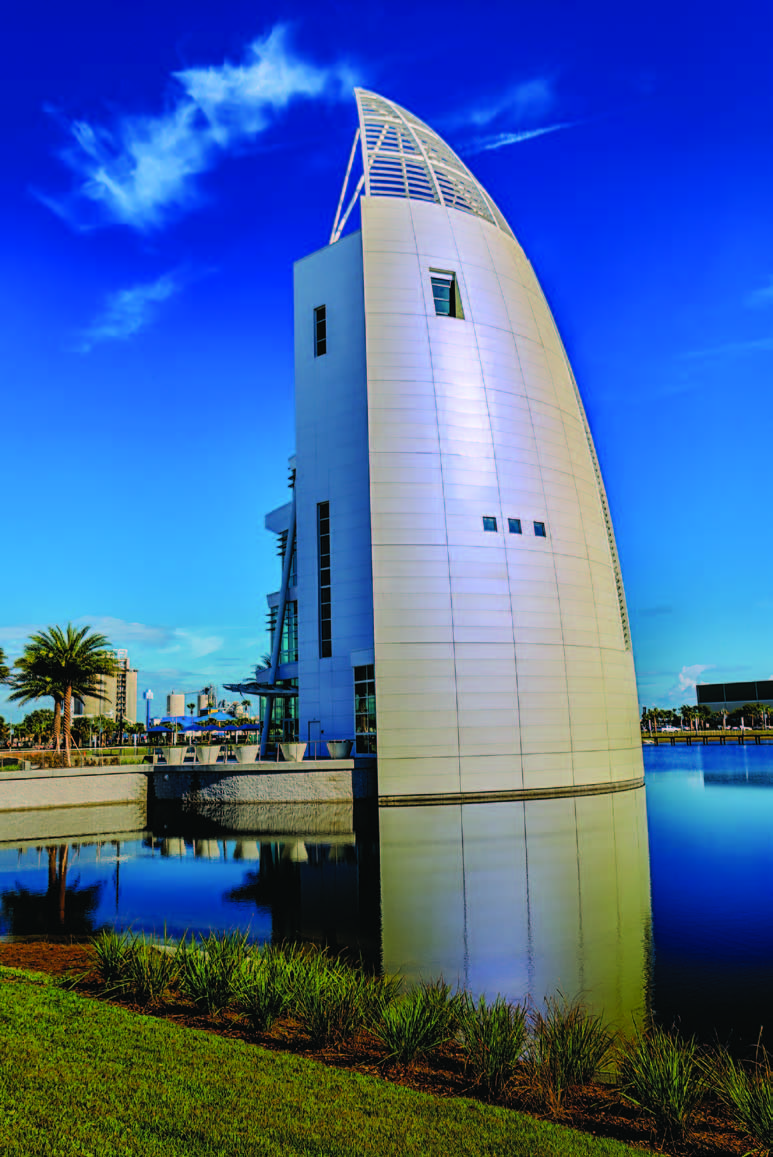With its shimmering, iridescent exterior, Exploration Tower at Port Canaveral, Fla., beckons visitors with its unique appearance as its color changes in different light and at different angles.
Opened in November 2013, the Port’s iconic welcome center showcases the first use of Valspar’s new Kameleon™ Color mica coating as spray-applied to Firestone Metal Products’ UNA-CLAD™ metal wall panels by Linetec, one the nation’s largest finishers of architectural aluminum.
An integral part of Florida’s Space Coast and Canaveral Cove’s revitalization, Exploration Tower is owned by Canaveral Port Authority. Its opening coincided with the Port’s 60th anniversary of its establishment and the 500th anniversary of Ponce de Leon’s landing on Florida’s east coast.
Taking its cues from the shapes and hues of the port, GWWO Inc./Architects designed the $23 million, seven-story, sail-shaped structure to express the common characteristics of “transience, function and imagery.” The building’s southern elevation soars from the water to the sky. It narrows in scale and reduces its exterior coverage until only the steel frame remains to outline the curvature and comes together at a peak 60-feet above the main roof level.
The architects elaborate, “The building’s dynamic form and features – sun louvers, exposed structure and iridescent skin -- contribute to a constant sense of movement as the sun plays across the structure, meet functional needs, and evoke imagery of the Port and [Brevard] County. A rocket ready to launch, a surfboard in the sand, a ship’s hull, a rocket contrail; all can be seen in the structure’s striking presence.”
Skanska USA served as the general contractor of the 23,000-sf project. Kenpat USA was the subcontractor responsible for the exterior metal façades and wall system. Working closely with Kenpat, Firestone engineered and fabricated the façade’s metal panel system.
Radius Track Corporation fabricated the curved structural faming and provided the 3-D building information modeling (BIM) to coordinate the connection points for each panel in the building’s parabolic curve. In total, Kenpat installed 42 pre-fabricated structural panelized units as sub-structure for the cladding, with the largest being 36 feet by 10 feet.
GWWO selected Valspar’s Blue Pearl II color-changing paint to capture the themes of revitalization and change it sought to represent for the Port Canaveral area. Along with its unique appearance, the finish must withstand Florida’s hurricane wind speeds, unrelenting sun and salt spray.
Kameleon Colors offer the same, advanced protection as Valspar’s 70% PVDF Fluropon® product family in rich, pearlescent pigments that shift in color when viewed from different angles. Applied in a three-coat system, Kameleon colors consist of a primer, basecoat and color coat, and are available for both extrusion and coil products.
“When creating a unique design that requires a vibrant color scheme, Kameleon Color is an excellent choice. This innovative, multicolored system uses mica flakes to create a consistent, iridescent look,” notes Tim Tritch, Valspar’s director of sales. The coating utilizes a blend of ceramic and inorganic pigments create this rich look that is both brilliant and subtle.”
Linetec also applied a clear coat over the Blue Pearl II for enhanced durability. As with other 70% PVDF resin-based coatings, Kameleon Colors meet the most stringent, exterior, architectural specification, American Architectural Manufacturers Association’s AAMA-2605. This specification requires paint coatings to meet rigorous testing performance standards, including more than 2,000 hours of cyclic corrosion per ASTM G85 annex 5, and heat- and humidity-resistance. Per AAMA-2605, the coating also must maintain its film integrity, color retention, chalk resistance, gloss retention, and erosion resistance properties for a minimum of 10 years on the South Florida testing site.
“If anyone can spray this and make it look good, it would be Linetec,” said GWWO’s senior associate, John Gregg, AIA, LEED AP, AVS, during a project planning meeting.
Accepting the praise with confidence, Linetec’s paint plant manager Paul Bratz says, “No one has sprayed this before, but our knowledgeable staff was up to the challenge. There was some trial and error during the process. It was critical that each paint run maintained the same parameters. The spray conditions, paint prep and application consistency of the paint itself were all critical. The slightest change could alter the look of the paint.”
To ensure consistency and minimize variation, Linetec modified its existing paint protocol process. Bratz explains, “The amount of paint needed for the entire project was determined and ordered as a single batch at the beginning of the project. Valspar prepared the special mica technology paint all at one time with excellent consistency, taking out the variable of multiple paint batches.”
In addition to the Kameleon Colors’ Blue Pearl II finish on southern seaside elevation, Linetec also applied Valspar’s Fluropon White finish to the northern elevation’s aluminum-framed curtainwall offering views of the bustling port. The entire project was painted in four phases, starting in March 2013 and ending in May.
Owner: Canaveral Port Authority
Master planning: AECOM, GWWO Inc./Architects
Architect: GWWO Inc./Architects
General contractor: Skanska USA Building
Structural engineer: Thornton Tomasetti
Exterior cladding system – installing contractor: KENPAT USA LLC
Exterior cladding system – manufacturer: Firestone Metal Products
Exterior cladding system – 3-D modeling: Radius Track Corporation
Exterior cladding system – coatings manufacturer: The Valspar Corporation
Exterior cladding system – finisher: Linetec
Related Stories
| Nov 2, 2010
Energy Analysis No Longer a Luxury
Back in the halcyon days of 2006, energy analysis of building design and performance was a luxury. Sure, many forward-thinking AEC firms ran their designs through services such as Autodesk’s Green Building Studio and IES’s Virtual Environment, and some facility managers used Honeywell’s Energy Manager and other monitoring software. Today, however, knowing exactly how much energy your building will produce and use is survival of the fittest as energy costs and green design requirements demand precision.
| Nov 2, 2010
Yudelson: ‘If It Doesn’t Perform, It Can’t Be Green’
Jerry Yudelson, prolific author and veteran green building expert, challenges Building Teams to think big when it comes to controlling energy use and reducing carbon emissions in buildings.
| Nov 2, 2010
Historic changes to commercial building energy codes drive energy efficiency, emissions reductions
Revisions to the commercial section of the 2012 International Energy Conservation Code (IECC) represent the largest single-step efficiency increase in the history of the national, model energy. The changes mean that new and renovated buildings constructed in jurisdictions that follow the 2012 IECC will use 30% less energy than those built to current standards.
| Nov 1, 2010
Sustainable, mixed-income housing to revitalize community
The $41 million Arlington Grove mixed-use development in St. Louis is viewed as a major step in revitalizing the community. Developed by McCormack Baron Salazar with KAI Design & Build (architect, MEP, GC), the project will add 112 new and renovated mixed-income rental units (market rate, low-income, and public housing) totaling 162,000 sf, plus 5,000 sf of commercial/retail space.
| Nov 1, 2010
John Pearce: First thing I tell designers: Do your homework!
John Pearce, FAIA, University Architect at Duke University, Durham, N.C., tells BD+C’s Robert Cassidy about the school’s construction plans and sustainability efforts, how to land work at Duke, and why he’s proceeding with caution when it comes to BIM.
| Nov 1, 2010
Vancouver’s former Olympic Village shoots for Gold
The first tenants of the Millennium Water development in Vancouver, B.C., were Olympic athletes competing in the 2010 Winter Games. Now the former Olympic Village, located on a 17-acre brownfield site, is being transformed into a residential neighborhood targeting LEED ND Gold. The buildings are expected to consume 30-70% less energy than comparable structures.
| Oct 27, 2010
Grid-neutral education complex to serve students, community
MVE Institutional designed the Downtown Educational Complex in Oakland, Calif., to serve as an educational facility, community center, and grid-neutral green building. The 123,000-sf complex, now under construction on a 5.5-acre site in the city’s Lake Merritt neighborhood, will be built in two phases, the first expected to be completed in spring 2012 and the second in fall 2014.
| Oct 21, 2010
GSA confirms new LEED Gold requirement
The General Services Administration has increased its sustainability requirements and now mandates LEED Gold for its projects.
| Oct 18, 2010
World’s first zero-carbon city on track in Abu Dhabi
Masdar City, the world’s only zero-carbon city, is on track to be built in Abu Dhabi, with completion expected as early as 2020. Foster + Partners developed the $22 billion city’s master plan, with Adrian Smith + Gordon Gill Architecture, Aedas, and Lava Architects designing buildings for the project’s first phase, which is on track to be ready for occupancy by 2015.
















